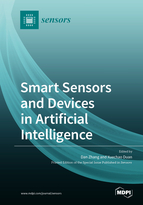Smart Sensors and Devices in Artificial Intelligence
A special issue of Sensors (ISSN 1424-8220). This special issue belongs to the section "Sensor Networks".
Deadline for manuscript submissions: closed (30 June 2020) | Viewed by 122177
Special Issue Editors
Interests: robotics and mechatronics; high-performance parallel robotic machine development; sustainable/green manufacturing systems; micro/nanomanipulation and MEMS devices (sensors); micro mobile robots and control of multi-robot cooperation; intelligent servo control system for the MEMS-based high-performance micro-robot; web-based remote manipulation; rehabilitation robot and rescue robot
Special Issues, Collections and Topics in MDPI journals
Interests: parallel robots; mechatronics; intelligent control; design optimization
Special Issues, Collections and Topics in MDPI journals
Special Issue Information
Dear Colleagues,
Sensors are eyes or/and ears of an intelligent system, such as UAV, AGV and robots. With the development of material, signal processing and multidisciplinary interactions, more and more smart sensors are proposed and fabricated under increasing demands for homes, industry and military fields. Networks of sensors will be able to enhance the ability to obtain huge amounts of information (big data) and improve precision, which also mirrors the developmental tendency of modern sensors. Moreover, artificial intelligence is a novel impetus for sensors and networks, which gets sensors to learn and think and feed more efficient results back.
This Special Issue welcomes new research results from academia and industry, on the subject of “Smart Sensors and Networks”, especially sensing technologies utilizing Artificial Intelligence. The Special Issue topics include, but are not limited to:
- smart sensors
- biosensors
- sensor network
- sensor data fusion
- artificial intelligence
- deep learning
- mechatronics devices for sensors
- applications of sensors for robotics and mechatronics devices
The Special Issue also welcome excellent extended papers invited from the 2018 2nd International Conference on Artificial Intelligence Applications and Technologies (AIAAT 2018) and 2019 3rd International Conference on Artificial Intelligence Applications and Technologies (AIAAT 2019).
Prof. Dr. Dan Zhang
Prof. Dr. Xuechao Duan
Guest Editors
Manuscript Submission Information
Manuscripts should be submitted online at www.mdpi.com by registering and logging in to this website. Once you are registered, click here to go to the submission form. Manuscripts can be submitted until the deadline. All submissions that pass pre-check are peer-reviewed. Accepted papers will be published continuously in the journal (as soon as accepted) and will be listed together on the special issue website. Research articles, review articles as well as short communications are invited. For planned papers, a title and short abstract (about 100 words) can be sent to the Editorial Office for announcement on this website.
Submitted manuscripts should not have been published previously, nor be under consideration for publication elsewhere (except conference proceedings papers). All manuscripts are thoroughly refereed through a single-blind peer-review process. A guide for authors and other relevant information for submission of manuscripts is available on the Instructions for Authors page. Sensors is an international peer-reviewed open access semimonthly journal published by MDPI.
Please visit the Instructions for Authors page before submitting a manuscript. The Article Processing Charge (APC) for publication in this open access journal is 2600 CHF (Swiss Francs). Submitted papers should be well formatted and use good English. Authors may use MDPI's English editing service prior to publication or during author revisions.
Keywords
- smart sensors
- biosensor
- sensor network
- sensor data fusion
- artificial intelligence
- deep learning
- robotics
- mechatronics devices
Benefits of Publishing in a Special Issue
- Ease of navigation: Grouping papers by topic helps scholars navigate broad scope journals more efficiently.
- Greater discoverability: Special Issues support the reach and impact of scientific research. Articles in Special Issues are more discoverable and cited more frequently.
- Expansion of research network: Special Issues facilitate connections among authors, fostering scientific collaborations.
- External promotion: Articles in Special Issues are often promoted through the journal's social media, increasing their visibility.
- Reprint: MDPI Books provides the opportunity to republish successful Special Issues in book format, both online and in print.
Further information on MDPI's Special Issue policies can be found here.








